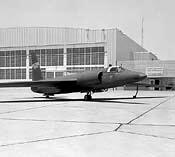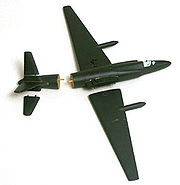The unfolding
drama reveals as much about aerial surveillance
and high diplomacy during the Cold War as it
does about personal courage in the face of
sudden adversity. The U2 plane was essentially a
powered glider capable of cruising at an
altitude of over 60,000 feet. U2s began
reconnaissance missions over the USSR in 1956
and were equipped with high-resolution cameras
to document Moscow’s missile build-up.
The planes were
designed by Lockheed, operated by the Central
Intelligence Agency (CIA, aka the agency), and
flown by civilian pilots “sheep dipped” from the
U.S. Air Force and under contract to the Agency.
In case of an incident, each plane carried an
explosive charge to destroy the film and camera,
and each pilot was offered an optional poison
pin. These measures were meant to ensure that
sensitive imagery intelligence would not fall
into the wrong hands and reassure the pilot that
he always had the option of taking his own life
if captured and facing possible torture.
The Soviets knew
about the over flights but kept quiet for fear
that public accusations would simply highlight
their impotence. Indeed, they tracked every U2
mission over the USSR by radar but were unable
to intercept any of them due to their extreme
altitude. Apparently, Powers simply had bad
luck.
Powers' projected
flight from Peshawar, Pakistan to Bodo, Norway
was to take 9 ½ hours and cover 3788 miles, most
of it in Soviet airspace. However, at Sverdlovsk
in the Urals he passed over two Soviet
battalions equipped with new S-75
surface-to-air-missiles (SAM). It was one of the
SAMs that exploded behind Powers and tore the
flimsy U2 apart. Another SAM, mistakenly fired,
hit a MiG flying below Powers, killing the
Soviet pilot. Against all odds, Powers was able
to parachute safely to the ground where he was
immediately arrested and taken for interrogation
to the dreaded KGB headquarters at the Lubyanka
in Moscow.
The disappearance
of Powers’ U2 occurred at a critical moment in
U.S.-Soviet relations. The leaders of the four
Allied nations of World War II—Dwight Eisenhower
for the United States, Nikita Khrushchev for the
Soviet Union, Harold Macmillan for Great Britain
and Charles de Gaulle for France—were about to
convene in Paris to discuss a range of issues
troubling the relations between their states.
Khrushchev, for one, hoped to make headway with
his proposal to have Berlin neutralized and
denuded of Western troops.

On May 1, 1960,
U.S. pilot Francis Gary Powers was navigating
his U2 reconnaissance aircraft over the Ural
Mountains deep inside the Soviet Union, when
suddenly a dull thump rocked the plane and a
tremendous orange flash lit the cockpit and sky.
“My God, I’ve had it now!” Powers exclaimed as
his plane began spinning. The Story of U2 pilot
Francis Gary Powers by Thomas Boghardt –
Historian – International Spy Museum,
Washington, D.C. Ignorant of Powers’ fate, CIA
Deputy Director for Plans Richard Bissell
informed President Eisenhower that the pilot’s
chance of survival was “one in a million”. When
the Soviets announced that a U.S. plane had
penetrated their airspace and gone down, the
State Department therefore replied deceptively
that an American weather plane gone off course
and possibly crashed in the USSR.
The American
cover story was issued under the assumption that
the Soviets had not captured the pilot alive and
available to corroborate their claim. On May 7,
1960, Khrushchev revealed to the Supreme Soviet
and the world that Powers was alive, and to a
chorus of “shame, shame” and “bandits, bandits”
touted photographs allegedly taken by the U2
camera. Against advice from the British prime
minister and the U.S. ambassador to Moscow to
stay silent, Eisenhower now publicly assumed
full responsibility for the U2 flight. On the
opening day of the Paris summit, May 16, 1960,
Khrushchev demanded from Eisenhower an apology,
an assurance that U2 over flights over the
Soviet Union cease and punishment of the guilty.
Predictably, Eisenhower declined. In response,
Khrushchev not only left the summit but also
peremptorily cancelled a scheduled presidential
visit to Moscow. America’s public humiliation
seemed complete.
Newsweek reported
that espionage experts had expected Powers to
perish and Aviation Week wrote of Powers’
survival. Eisenhower angrily assumed Powers had
“started talking as soon as he hit the ground.”
Meanwhile, Powers languished in a Soviet prison.
In 1962, Powers was swapped for a Soviet spy and
returned to the United States where the CIA
thoroughly debriefed him. The Agency came down
firmly on Powers’ side—they reported that
Powers’ had a poison pen that he could use if he
was being tortured. The CIA said the use of the
poison pin was entirely optional, its final
report concluded, and he only failed to activate
the camera’s destruct mechanism due to the
extreme g-forces in his rapidly sinking plane.
In addition, the report pointed out, in case of
capture he was at liberty to tell his captors
all about his mission except for certain
technical data. In short, Powers had acted in
complete accordance with his instructions. The
following year, he was awarded the CIA’s coveted
Intelligence Star. Still, the CIA’s report was
classified for many years.
Sadly, Francis
Gary Powers died in a helicopter crash in 1977.
Powers’ final vindication would not come until
2006 when two researchers, Timothy Naftali and
Aleksander Fursenko, discovered the notes of his
interrogation in Moscow. Although questioned for
eleven hours a day, every day, Powers said
little of consequence and nothing proscribed by
the CIA’s policy for captured pilots. He even
concealed from his captors the U2’s cruising
altitude, how often he had over flown Soviet
territory and the names of his CIA superiors. He
also refused to explain for several days how he
had maintained radio contact with U.S.
authorities. Overall, he displayed remarkable
nerve, breaking out in tears only when his
interrogators read him a comment from his
father. When they suggested he was sent
deliberately to scuttle the Paris summit,
Powers’ response was curt and patriotic: “I
don’t know why I was sent. There must have been
good reasons.”
|
Francis Gary
Powers left the United States Air Force with the
rank of captain in 1956, to join the CIA U2
program. U2 pilots carried out espionage
missions using a spy plane that could reach
altitudes above 70,000 feet, essentially making
it invulnerable to Soviet anti-aircraft weapons
of the time. The U2 was equipped with a
state-of-the-art camera designed to snap
high-resolution photos from the edge of the
atmosphere over hostile countries that included
the Soviet Union. These cameras systematically
photographed military installations and other
important intelligence targets.
Soviet
intelligence, including the KGB, had been well
aware of U2 missions since 1956, but lacked the
technology to launch counter-measures until
1960. Powers’ U2, which departed from a military
airbase in Peshawar and may have received
support from the US Air Station at Badaber
(Peshawar Airbase), near Peshawar in Pakistan,
was shot down by an S-75 Dvina (SA-2 Surface to
Air) missile on May 1, 1960, over Sverdlovsk.
Powers was unable to activate the plane's
self-destruct mechanism, as instructed, before
he parachuted to the ground and into the hands
of the KGB.
When the U.S.
government learned of Powers' disappearance over
the Soviet Union, it issued a cover statement
claiming that a "weather plane" had crashed down
after its pilot had "difficulties with his
oxygen equipment”. What U.S. officials did not
realize was that the plane crashed almost fully
intact, and the Soviets recovered its
photography equipment, as well as Powers, whom
they interrogated extensively for months before
he made a "voluntary confession “and public
apology for his part in U. S. espionage.
Ultimately the whole incident would set back the
peace talks between Khrushchev and Eisenhower
for years.
On August 17,
1960, Powers was convicted of espionage against
the Soviet Union. He was sentenced to a total of
10 years in prison, three years of imprisonment
followed by seven years of hard labor. Powers
was held in the famous "Vladimirsky Central"
prison in the city of Vladimir, east of Moscow.
This prison had been used to hold other
high-profile prisoners, such as the son of
Joseph Stalin. The prison, which is still active
today, contains a small museum that includes an
exhibit on Powers. Francis Gary Powers had a
good rapport with Russian prisoners during his
time there. On February 10, 1962, twenty-one
months after his capture, he was exchanged along
with American student Frederic Pryor in a spy
swap for Soviet KGB Colonel Vilyam Fisher (aka
Rudolf Abel) at the Glienicke Bridge in Berlin,
Germany.
|




















